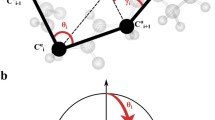Abstract
Experiments on the dynamics of vibrational fluctuations in myoglobin revealed an interesting behavioral cross-over occurring in the range 180–200 K. In this temperature range the mean square displacement of atomic positions versus temperature sharply increases its slope, indicating the dissociation of CO from the heme group. In this paper we develop a theoretical model that provides a framework for the quantitative description of this phenomenon. The basis of our calculations is an assumption of an effective potential with multiple local minima. In particular, we consider a quartic potential in place of the simple quadratic. We then use non-Gaussian statistics to obtain a relationship between the mean square displacement and model parameters. We compare our model to published experimental data and show that it can describe the data set using physically meaningful parameters which are fitted to the experimental data. In the process we verify the Gaussian approximation's applicability only to the low-temperature régime. In the high-temperature limit, however, deviations from the Gaussian approximation are due to the double-well nature of our effective potential. We find that the published datasets showing the thermal transition display the qualitative trends predicted by appropriate algebraic approximations to our predicted myoglobin behavior.











Similar content being viewed by others
References
Abramowitz M, Stegun IA (eds) (1972) Handbook of mathematical functions with formulas, graphs, and mathematical tables. Dover, New York
Achterhold K, Keppler C, Ostermann A, van Bürck U, Sturhahn W, Alp EE, Park FG (2002) Vibrational dynamics of myoglobin determined by the phonon-assisted Mössbauer effect. Phys Rev E 65:051 916
Berg JM, Tymoczko J, Stryer L (2002) Biochemistry, 5th edn. Freeman, New York
Branden C, Tooze J (1999) Introduction to protein structure, 2nd edn. Taylor and Francis, London
Cordone L, Ferrand M, Vitrano E, Zaccai G (1999) Harmonic behavior of trehalose-coated carbon-monoxy-myoglobin at high temperature. Biophys J 76:1043–1047
Doster W, Cusack S, Petry W (1989) Dynamical transition of myoglobin revealed by inelastic neutron scattering. Nature 337:754–756
Ferrand M, Dianoux AJ, Petry W, Zaccai G (1993) Thermal motions and function of bacteriorhodopsin in purple membranes: Effects of temperature and hydration studied by neutron scattering. Proc Natl Acad Sci USA 90:9668–9672
Frauenfelder H, McMahon B, Stojković BP (1998) Is myoglobin like a Swiss watch? In: Matsson L (ed) Proceedings of the Adriatico research conference on nonlinear co-operative phenomena in biological systems. World Scientific, Singapore, p 145
Howard J (2001) Mechanics of motor proteins and the cycloskeleton. Sinauer, Sunderland, Mass
Neinhaus GU, Heinzl J, Huenges E, Parak F (1989) Protein crystal dynamics studied by time-resolved analysis of x-ray diffuse scattering. Nature 338:665
Nienhaus GU, Waschiply R, Nienhaus K, Minkow O, Ostermann A, Parak FG (2001) Ligand migration and binding in myoglobin mutant l29w. In: Proceedings of the first biological physics conference, Bangkok, Thailand. World Scientific, Singapore, p 56
Ostermann A, Waschipky R, Parak FG, Nienhaus GU (2000) Ligand binding and conformational motions in myoglobin. Nature 404:205–208
Parak FG (2001) Fluctuations and relaxations in proteins. In: Proceedings of the first biological physics conference, Bangkok, Thailand. World Scientific, Singapore, p 7
Parak FG, Achterhold K (1999) Protein dynamics studied on myoglobin. Hyperfine Interact 123:825–840
Parak F, Knapp E, Kucheida D (1982) Protein dynamics. Mossbauer spectroscopy on deoxymyoglobin crystals. J Mol Biol 161:177–194
Steinbach PJ, Brooks BR (1993) Protein hydration elucidated by molecular dynamics simulation. Proc Natl Acad Sci USA 90:9135–9139
Steinbach PJ, Brooks BR (1996) Hydrated myoglobin's anharmonic fluctuations are not primarily due to dihedral transitions. Proc Natl Acad Sci USA 93:55–59
Tama F, Miyashita O, Kitao A, Go N (2000) Molecular dynamics simulation shows large volume fluctuations of proteins. Eur Biophys J 29:472–480
Tuszyński JA, Wierzbicki A (1991) Non-Gaussian approach to critical fluctuations in the Landau-Ginzburg model and finite-size scaling. Phys Rev B 43:8472–8481
Tuszyński JA, Clouter MJ, Kiefte H (1985) Beyond the Gaussian approximation: some new results in the Landau theory of phase transitions. Phys Lett A 108:272–276
Tuszyński JA, Clouter MJ, Kiefte H (1986) Non-Gaussian models for critical fluctuations. Phys Rev B 33:3423–3435
Acknowledgements
This research has been supported by MITACS, NSERC, and the Theoretical Physics Institute of the University of Alberta. Part of this research was carried out with the support of a senior fellowship for J.A.T. at the University of Leuven. We wish to thank Mr. W. Malinski for his assistance in data analysis. J.M.D. would like to thank the staff and members of the Physics Department, University of Alberta, for all their kindness and thoughtfulness during his stay.
Author information
Authors and Affiliations
Corresponding author
Appendix
Appendix
Appendix A: derivation of potential
In this appendix we show how to fix the three parameters a, b, and c to provide a unique potential. We consider Eqs. (1), (6), V(x A)=d A (by definition), and choose x A<x B; it is then possible to obtain by algebraic manipulation:
Further algebra and the change of variable c=fw produces:
We are interested in the case that 0≥r≥1, r \( \in \) R. It can be shown that while in general there are four roots for f, only one:
corresponds to the case we are interested in and lies in the range [0, −1/2].
Appendix B: derivation of <x 2>
Each of the integrals in Eq. (10) can be evaluated using the formula (Tuszyński et al. 1985, 1986; Tuszyński and Wierzbicki 1991):
where D −p is a parabolic cylinder function and Γ(p) a standard Gamma function (Abramowitz and Stegun 1972). Applying this method we obtain:
and:
The parabolic cylinder function has two well-known asymptotic limits, namely for \( x \approx 0 \):
and for x>>1:
Rights and permissions
About this article
Cite this article
Tuszyński, J.A., Carpenter, E.J., Dixon, J.M. et al. Non-Gaussian statistics of the vibrational fluctuations of myoglobin. Eur Biophys J 33, 159–166 (2004). https://doi.org/10.1007/s00249-003-0351-6
Received:
Revised:
Accepted:
Published:
Issue Date:
DOI: https://doi.org/10.1007/s00249-003-0351-6




